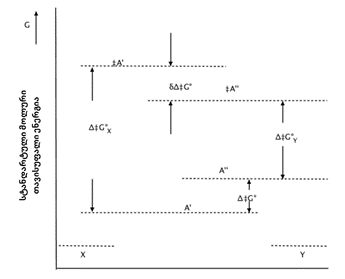ქიმიის ტერმინთა განმარტებითი ლექსიკონი
- ინგლისურ-ქართული
- ქართულ-ინგლისური
- ლექსიკონის შესახებ
- გამოხმაურება

| Curtin–Hammett principle | კურტინ-ჰამეტის პრინციპი |
| In a chemical reaction that yields one product (X) from one conformational isomer (A′) and a different product (Y) from another conformational isomer (A′′) (and provided these two isomers are rapidly interconvertible relative to the rate of product formation, whereas the products do not undergo interconversion) the product composition is not in direct proportion to the relative concentrations of the conformational isomers in the substrate ; it is controlled only by the difference in standard free energies of the respective transition states.
|
ქიმიურ რეაქციაში, რომლის დროსაც წარმოიქმნება ერთი პროდუქტი (X) ერთი კონფორმაციული იზომერისგან (A′) და განსხვავებული პროდუქტი (Y) სხვა კონფორმაციული იზომერისგან (A′′) (და იმ პირობით, რომ ეს ორი იზომერი სწრაფად ურთიერთგარდაიქმნება პროდუქტის წარმოქმნის სიჩქარესთან შედარებით, ხოლო პროდუქტები ერთმანეთში არ გარდაიქმნებიან), პროდუქტის შემადგენლობა არ არის სუბსტრატში კონფორმაციული იზომერების ფარდობითი კონცენტრაციების პირდაპირპროპორციული; იგი კონტროლდება მხოლოდ შესაბამისი გარდამავალი მდგომარეობების სტანდარტული თავისუფალი ენერგიების სხვაობით.
|
| Source | წყარო: PAC, 1994, 66, 1077 (Glossary of terms used in physical organic chemistry (IUPAC Recommendations 1994)) on page 1102 |
|











